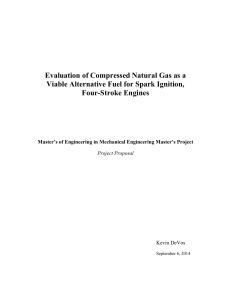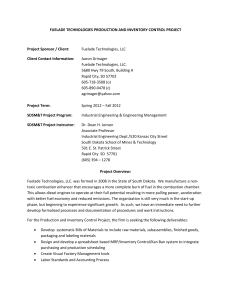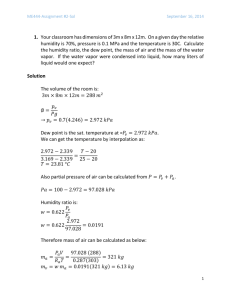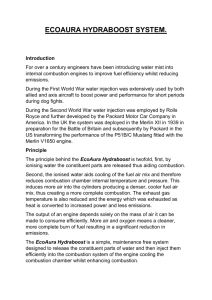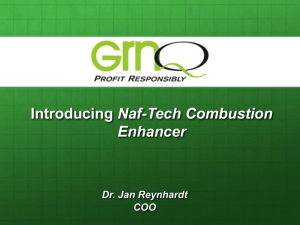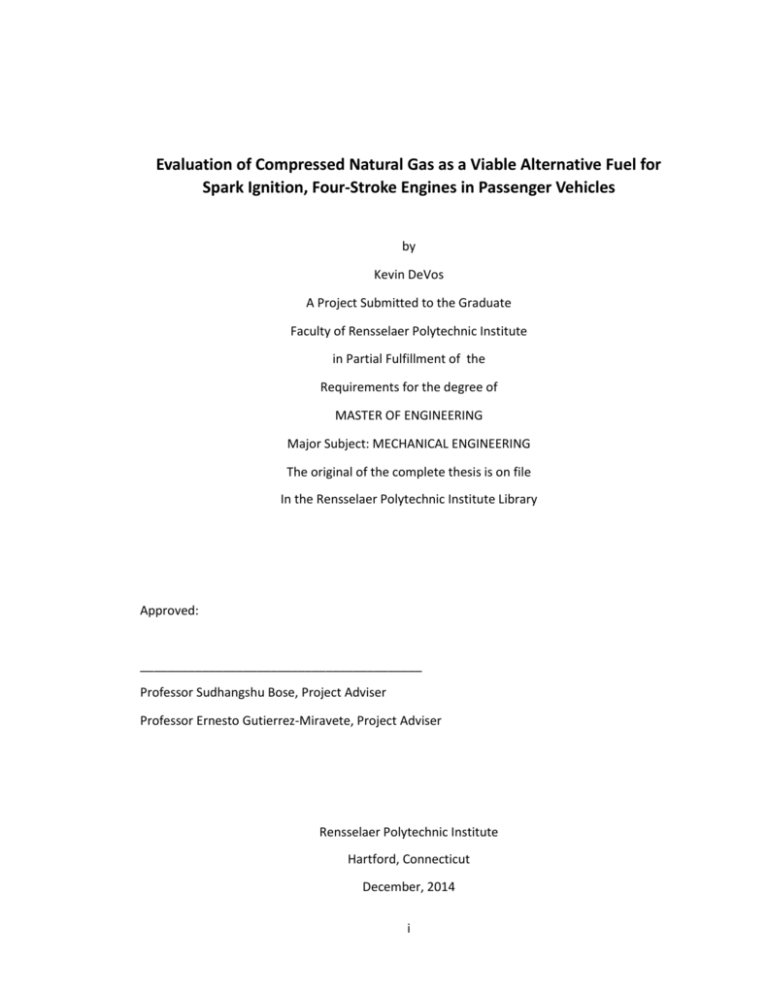
Evaluation of Compressed Natural Gas as a Viable Alternative Fuel for
Spark Ignition, Four-Stroke Engines in Passenger Vehicles
by
Kevin DeVos
A Project Submitted to the Graduate
Faculty of Rensselaer Polytechnic Institute
in Partial Fulfillment of the
Requirements for the degree of
MASTER OF ENGINEERING
Major Subject: MECHANICAL ENGINEERING
The original of the complete thesis is on file
In the Rensselaer Polytechnic Institute Library
Approved:
_________________________________________
Professor Sudhangshu Bose, Project Adviser
Professor Ernesto Gutierrez-Miravete, Project Adviser
Rensselaer Polytechnic Institute
Hartford, Connecticut
December, 2014
i
© Copyright 2014
by
Kevin DeVos
All Rights Reserved
ii
CONTENTS
LIST OF TABLES .............................................................................................................................. iv
LIST OF FIGURES.............................................................................................................................. v
DEFINITIONS .................................................................................................................................. vi
ACRONYMS ................................................................................................................................... vii
NOMENCLATURE ......................................................................................................................... viii
ACKNOWLEDGMENT ..................................................................................................................... ix
ABSTRACT ....................................................................................................................................... 1
1. Introduction ............................................................................................................................. 2
1.1
Background .................................................................................................................... 2
1.2
Previous Work ............................................................................................................... 8
2. Theory ...................................................................................................................................... 3
2.1
Otto Cycle ...................................................................................................................... 3
2.2
Suitability of Fuels.......................................................................................................... 3
2.2.1
Chemical Properties of Natural Gas ................................................................. 4
3. Methodology ............................................................................................................................ 5
3.1
Combustion Process ...................................................................................................... 5
3.1.1
Exhaust Emissions ............................................................................................. 5
4. Results and Discussion ............................................................................................................. 8
4.1
ASDF ............................................................................................................................... 8
5. Conclusion .............................................................................................................................. 11
6. References.............................................................................................................................. 12
6.1
Works Cited ................................................................................................................. 12
6.2
Additional References Consulted ................................................................................ 12
7. Appendices ............................................................................................................................. 13
iii
LIST OF TABLES
Table 1:
iv
LIST OF FIGURES
Figure 1:
v
DEFINITIONS
Internal Combustion Engine
An engine in which fuel is burned inside an enclosed volume
and where the combusted fuel directly acts upon a piston in
order to produce mechanical work.
Stoichiometric ratio
The ratio of air to fuel which theoretically results in complete
combustion with no leftover reactants.
Equivalence ratio (φ)
The ratio of the actual fuel/air ratio with the stoichiometric
fuel/air ratio.
Knock
The autoignition of a portion of the air/fuel charge in front of
the flame front created by the spark plug. Knock generally
occurs at high cylinder temperatures and pressures. Each fuel
has a characteristic resistance to knock which is described by
its research octane number.
Preignition
The autoignition of the air/fuel charge in a spark ignition engine
before the spark plug fires. Preignition is often also known as
dieseling because of its similarity to the operation compression
ignition (diesel) engines.
Octane Number
vi
ACRONYMS
The following is a list of acronyms and abbreviations that are used throughout this paper.
Acronym
Definition
CNG
Compressed Natural Gas
ICE
Internal Combustion Engine
BMEP
Brake Mean Effective Pressure
vii
NOMENCLATURE
The following is a list of nomenclature used throughout this paper:
Symbol
Description
viii
Unit
ACKNOWLEDGMENT
I would like to thank
ix
ABSTRACT
This project assesses compressed natural gas (CNG) fueled vehicles and evaluates their
suitability as alternatives to traditional gasoline powered passenger vehicles. First, the
combustion process, specific fuel consumption, and overall efficiency of a CNG four-stroke
engine is discussed and compared to a typical gasoline four-stroke engine. Environmental
benefits are explored, including reduced vehicle particle emissions and greenhouse gas
emissions. Finally, practical concerns of using CNG as a fuel source, such as access to fueling
stations and dangers of vehicular accidents, are presented.
1
1. Introduction
1.1 Background
With the beginning of the industrial revolution in the late 1700s, work has progressed to
convert the chemical energy in various fuel sources to motion. The invention of the
combustion engine, first developed in the form of a steam engine, allowed vehicles to be
propelled by stored onboard fuel instead of by an external mechanism, such as being pulled by
a horse. The internal combustion engine was a further improvement on this principal. It
increased the efficiency and greatly decreased the required size of the engine for a given power
output. These engines were generally small enough that they could be attached to wheeled
vehicles and used as the basis of practical transportation. These early contraptions would
quickly evolve to become the automobiles that we know today.
There are approximately 1 billion passenger vehicles in the world and about 25% of those are in
the United States. [7] The vast majority of these vehicles are spark ignition, gasoline fueled
vehicles. Recently, environmental and political pressures have highlighted the need for
alternative fuels that are more readily available and the combustion of which causes less
environmental pollution. Specifically, the corporate average fuel economy (CAFE) standards
that are being imposed upon manufacturers of automobiles is forcing them to greatly increase
the fuel economy of their vehicle fleets. Compressed natural gas has emerged as a possible
fuel due to its relative abundance and cleaner burning properties.
This project will analyze the viability of using CNG for personal vehicles will be explored. This
will include a theoretical efficiency study, a comparison of vehicle emissions with conventional
automobiles, and a discussion of pragmatic realities of operating an alternative energy vehicle.
2
2. Theory
2.1 Otto Cycle
The Otto cycle is the basis of the four cycle spark ignition engine. Within each cylinder of a four
cycle engine, a piston sliding inside the cylinder draws fuel in, ignites it, harnesses the power of
the fuel as it burns, and then exhausts it from the cylinder. The four cycles correspond to a
single stroke of the piston and can be described as inlet, compression, combustion, and
exhaust. At the start of the inlet stroke, the piston is at the top of the cylinder. It slides down
the cylinder and at the same time, a valve in the top of the cylinder opens allowing a charge of
air and fuel to enter. Once the piston reaches the bottom of its travel, the valve closes. The
piston then slides back up the cylinder bore, compressing the air and fuel mixture. When the
piston nears the top of its stroke, the air and fuel mixture is ignited by a spark plug. The air/fuel
mixture combusts which causes it to expand. The expanding gas mixture then drives the piston
downward. When the combustion has been completed and the piston reaches the bottom of
its travel, an exhaust valve opens. The piston moves up pushing the exhaust gases out of the
cylinder. The cycle is then repeated with a new charge of air and fuel.
2.2 Suitability of Fuels
The cycle described above is not specific to a type of fuel. Many different materials can be used
in such an engine to produce power. Due to the practicalities of producing, storing,
transporting, and selling fuels, some types of fuels are favored for commercial use. The
attributes of a good fuel include being inexpensive, energy dense, stable at room temperature,
abundant, and clean burning.
One family of fuels stands out as having many of these properties: saturated hydrocarbons.
Carbon atoms can form a total of four bonds with other atoms. Saturated hydrocarbons are
molecules composed of strings of carbon atoms with all open bond sites being taken by
hydrogen atoms. The simplest hydrocarbon is methane. It consists of one carbon atom
bonded to four hydrogen atoms, designated CH4. More complex molecules can be formed
when carbon atoms bond to each other as well as hydrogen atoms. When two carbon atoms
bond to each other and then each bonds with three hydrogen atoms, ethane (C2H6) is formed.
Longer strings such as propane (C3H8), butane (C4H10), and octane (C8H18), are formed when
more carbon atoms bond together. See Figure (XX) below. The gasoline that is used by most
passenger vehicles is a blend of hydrocarbons usually ranging from four carbon strings (C4H10)
to twelve carbon strings (C12H26).
3
Figure XX: Hydrocarbon strings
Energy is stored in the chemical bonds between atoms and can be released to produce work
through the chemical reaction of combustion.
2.2.1
Chemical Properties of Natural Gas
Natural gas is, as its name implies, a mixture of volatile gases that occur naturally. Natural gas
is approximately 95% methane. The remaining 5% is made up of higher level hydrocarbons as
well as some contaminants. [Citation needed] Natural gas is formed from the decomposition of
plant and animal matter. Small organisms, called methanogens, break down organic matter
and emit methane as a byproduct. Deposits of natural gas are found underground, commonly
in proximity to other petroleum products. Natural gas is extracted by drilling down to deposits
and capturing the gas released.
4
3. Methodology
3.1 Combustion Process
In the combustion process which is used by automobile internal combustion engines, the
hydrocarbons undergo oxidation. The hydrocarbons react with oxygen forming carbon dioxide
(CO2) and water (H20). The chemical reaction formula for complete combustion is given below.
CH4 + 2 O2 -> CO2 + 2 H2O + energy
[8][2]
However, the combustion process does not occur with pure oxygen but with air. That means
that there is a large portion of the incoming charge which is composed of nitrogen. The above
equation should then be rewritten as follows:
CH4 + 2O2 + 7.546N2 -> CO2 + 2H2O + 7.546N2 + energy
[Korakianitis]
Air/Fuel Ratio and how it plays a role in lean operation
The nitrogen is largely nonreactive in the combustion process. However, at temperatures
above 1,300 °C (2,370 °F) the nitrogen will begin to form compounds with oxygen. [EPA NOx]
These compounds are collectively known as nitrogen oxides, often shortened to NOx. The
combustion process primarily forms nitric oxide (NO). The introduction of NOx deviates from
the stoichiometric equation. Because the amount of nitric oxide is dependent on the
temperature at which the reaction occurs and the air fuel ratio , it cannot be analytically
predicted like the quantities Nitric oxide and other nitrogen oxides are responsible for much of
the smog production in cities.
3.1.1
Exhaust Emissions
The reaction products are effectively a byproduct that must be created in order to get the
product that we seek: namely energy in the form of heat. The oxidation reaction for
hydrocarbons necessarily results in carbon dioxide and water vapor. In addition, most engines
produce nitrogen oxides (NOx) as an unintended byproduct.
Other byproducts like unburned HC, CO,
Carbon dioxide (CO2) is a problematic emission. Research has shown that carbon dioxide is one
of a number of gases responsible for the greenhouse effect which is believed to be responsible
5
for climate change. However, the entire premise of using hydrocarbon combustion for energy
use is based on breaking apart the bonds between carbon and hydrogen and forming carbon
and hydrogen oxides. For the combustion of hydrocarbons the creation of carbon dioxide
cannot be prevented, but the ratio of carbon dioxide per amount of energy released can be
minimized. By choosing fuels with the largest number of hydrogen atoms per each carbon
atom, more energy can be released per molecule of carbon dioxide produced. As mentioned
above methane is the optimal fuel in this regard because each carbon has formed bonds with
four hydrogen atoms. This the maximum number of hydrogen bonds per carbon atom that
carbon’s chemical structure will allow.
Water vapor is formed in large quantities from the combustion of hydrocarbons. Water vapor
is classified as a greenhouse gas and as such can be linked to climate change. However, since
the amount of water vapor in the atmosphere is largely determined by the vast quantity of
water in the world’s oceans, adding additional water vapor via combustion does not affect the
overall concentration in the atmosphere. The concentration is regulated by evaporation and
precipitation as part of the natural water cycle.
Nitric oxide is also an unwelcome product. It reacts with sunlight to form ozone and
contributes to the smog found in many large cities. It impacts the air quality and can
exacerbate breathing difficulties.
6
4. Well to Wheel Emissions of CNG
4.1 Extraction
The extraction process of natural gas
See Waller.
7
5. Results and Discussion
5.1 ASDF
CNG has a lower energy content per unit volume than gasoline, but CNG fueled engines can
operate at higher compression ratios and therefore higher efficiencies. The tradeoffs involved
will be contrasted.
The stoichiometric equations for combustion indicate the resulting exhaust gases that will
make up the vehicle emissions. The predicted emissions will be compared to test data.
Additional lifecycle greenhouse gas emission differences will be discussed.
The practical concerns to be investigated include refueling, fuel concerns during accidents,
higher initial cost, and less range due to storage tank size.
Asdf
5.2 Previous Work
As the pressure to find an abundant, clean burning fuel has increased, significant research into
natural gas fueled engines has been performed.
It is known that the thermal efficiency of an engine increases with the compression ratio.
Zheng, in Reference [6], experimentally determined that increasing the compression ratio from
~9:1 for gasoline powered engines to ~12:1 allowed for increased efficiency without
significantly increasing unwanted emissions. In addition to higher compression ratios,
Reference [1] discusses how operating natural gas engines at an air/fuel ratio leaner than
stoichiometric can result in acceptable power with lower emissions. However, lean operation
and high compression ratios can result in high combustion temperatures. That leads to the
formation of large amounts of NOx as discussed in Reference [3]. Reference [5] discusses one
approach to keep the NOx production at low levels: the addition of supplementary hydrogen as
a secondary fuel.
8
5.3 Practical Realities of Natural Gas Vehicles
5.3.1
Initial Cost
The initial purchase cost of a CNG fueled vehicle is greater than a comparable gasoline fueled
vehicle.
5.3.2
Fuel Storage and Range
CNG has a lower energy content per unit volume than that of gasoline. The fact that natural
gas is just that, a gas, puts it at a disadvantage when it comes to storing energy. CNG must be
kept in fully sealed storage containers and must be pressurized to thousands of pounds per
square inch to even approach the energy density of gasoline.
Most gasoline automobiles sold today have gasoline storage tank capacities of 12-30 gallons.
The capacity is chosen to deliver a range between 300 and 500 miles. For a CNG fueled
automobile to replace a gasoline version, it must also have a range of approximately 300 miles.
Assuming that the efficiency of the engine has already been optimized, the pressure and
storage capacity dictate the range of the vehicle. The pressure of most CNG filling stations is
about 3600 psig [citation needed]. In order to achieve a range of 300 miles, a CNG fueled
vehicle needs to have a fuel storage capacity of XX cubic feet.
The tanks required to store the CNG also need to be capable of withstanding approximately
3600 psig. In addition to withstanding the internal pressure, tanks must resist degradation due
to environmental conditions (heat, water, road salt, oils) and mechanical damage in the event
of an accident.
5.3.3
Fuel Cost
Diesel is approximately $4/gallon. Gasoline is approximately $3.50/gallon. Natural gas is
approximately $XX per cubic foot or $XX for 1 gallon gasoline equivalent.
5.3.4
Fueling Stations
5.3.5
Maintenance
5.3.6
Fuel Safety
Natural gas does have a number of safety benefits over gasoline. Since it is a gas instead of a
liquid, it has high dispersal rates. Natural gas is lighter than air so it will tend to rise and
disperse into the atmosphere rather than pooling on the ground like gasoline. Natural gas is
non-toxic to people or animals. The only respiratory risk of natural gas is that it may displace
the oxygen needed for breathing if a leak occurs in a confined space. Even then, since it is
9
lighter than air, it will displace the oxygen at the highest point in the space first meaning that
the lowest points will still have breathable air.
10
6. Conclusion
In conclusion,
11
7. References
7.1 Works Cited
[1] Haeng Muk Cho, Bang-Quan He. “Spark ignition natural gas engines – A review”. Energy
Conversion and Management 48, 2007.
[2] Heywood, John B. Internal Combustion Engine Fundamentals. McGraw Hill, 1988. Print.
[3] Korakianitis, T., Namasivayam, A. M., Crookes, R. J. “Natural-gas fueled spark-ignition
(SI) and compression ignition (CI) engine performance and emissions”. Progress in
Energy and Combustion Science 37, 2011.
[4] Norton, Robert L. Design of Machinery – An Introduction to the Synthesis and Analysis of
Mechanisms and Machines. 3rd ed. McGraw Hill, 2004. Print.
[5] Tunestal, P., Christensen, M., Einewall, P., Andersson, T., and Johansson, B. “Hydrogen
Addition For Improved Lean Burn Capability of Slow and Fast Burning Natural Gas
Combustion Chambers”. Society of Automotive Engineers 2002-01-2686, 2002.
[6] Zheng, J. J., Wang, J. H., Wang, B., and Huang, Z. H. “Effect of the compression ratio on
the performance and combustion of a natural-gas direct-injection engine”. IMechE:
Vol. 223 Part D: J. Automobile Engineering, 2009.
[7] Ward’s Automotive Group. “Vehicles in Operation by Country”. Penton Media Inc. 2011.
[8] http://www.elmhurst.edu/~chm/vchembook/511natgascombust.html
7.2 Additional References Consulted
12
8. Appendices
8.1
13

